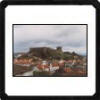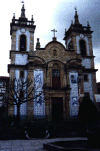Celorico da Beira’s Council
This council is located in the north slope of Serra da Estrela,
between the councils of Fornos de Algodres (at west), Gouveia
(at south), Guarda (at east) and Trancoso (at north). Situated
in Beira Alta, in Guarda’s district, this council has 22
parishes and 24 annexed in total area of 49,93kms2. It has a
population of about 10500 inhabitants.
The region of Celorico da Beira is ‘protected’ by Rio Mondego as
it surrounds Celorico by east, north and west, allowing it to
have a natural defense. Due to its strategical geographical
localization, the control of this village always signified the
domination of the natural gateway that included Mondego’s
valley. The economical development that was verified in this
area in the 16th century was, partially, a result of
the domain of this natural gateway and the obligatory passage of
the traders by it.
In the passage of its history, Celorico was lordship of several
families. Before the reign of D. Fernando it belonged to Martim
Vasques de Sousa. D. Isabel, an illegitimate daughter of D.
Fernando, received the lordship of Celorico in dowry by her
marriage in 1373 with the Count of Gijon. In the reign of D.
Manuel I, Celorico was given away to the first Count of
Portalegre. After the end of the Counts of Portalegre family,
D. Pedro II donated it to André Lopes de Lavre. This population
was also a lordship of the Marqueses de Gouveia.
The Celorico da Beira council offers to who visits it the charms
of the mountain landscape, having a vast patrimony of great
beauty in the landscapes as well as monumental and artistic.
A
visit through this council can reveal a continuous discovery of
centuries and centuries of history, in an environment of
mountain landscape where the granite is the king, marked by
creeks and crystalline water. In every place, in every village,
there are marks of ancients times worthy of being admired:
imposing manor houses with beautiful stones of arms, beautiful
churches and chapels, pillories, roman bridges and passages.
Photos:




Covilhã’s Council
Covilhã’s city is situated in the west slope of Serra da Estrela
at almost 700mts of altitude.
The Council has an area of over 550km2 and its population is
estimated in 54.506 inhabitants, of which 49.527 are voters)
according to data from Censos 2001).
Navigators, explorers and scientists that revolutionised
Mankind’s history have left from this city, among them there is
Infante D. Henrique (impulsive of the Discoveries) and Pedro
Alvares Cabral (Brazil discoverer).
Few are the urban centres that can assume a regular economical
activity for 8 centuries, but that’s the case of Covilhã and its
wool works. The working of the wool exists here for the past 800
years, which can be reflected mainly in modern industrial
activities, and Covilhã is one of the main centres of wool in
Europe. Actually this industry produces by year about 40000km of
this tissue, and it is the supplier of great world trade marks
such as Hugo Boss, Armani, Zenga, Marks & Spencer, Yves St.
Laurent, Calvin Klein and Christian Dior.
In the east slope, Covilhã offers to who visits it the beautiful
landscape of its houses, framed in a extraordinary amphitheatre
of mountains. This city is in the centre of a region were 9 of
the 10 Portuguese historical villages can be found. By its feet
a rich and fertile valley developed a valley with great fruit
cultures (cherry, peach, apple and pear) and winegrowing
aptitudes.
It is the closest city to the winter resort where the unique
Portuguese ski tracks are located and where you can go to see
amazing mountain landscapes. From Covilhã you can get the
shortest, simplest and panoramic access to the Tower and to
Serra da Estrela.
Going up to Penhas da Saude, we can see a magnificent resort for
holidays in ‘altitude’, where you can walk near Lago Viriato and
you’ll get closer to the glacier valleys of Manteigas and Unhais
da Serra, villages where you can find thermal areas. Several
belvederes allow you to see the greatness of Portugal and Spain
landscapes.
Covilhã is the university and technological centre where the
Universidade da Beira Interior is located, this university has
over 5000 students spread through several courses.
Covilhã is a modern city that promotes the development. You can
feel the beat of a city that shows itself has a municipal in a
constant progress, ready to face all challenges. This cities has
some curiosities at language level, using vocabulary different
from the usual, see some examples:
Acunapado – mal
remendado (port.) – bad amended (eng.)
Asseadona – vaidosa
(port.) – vain (eng.)
Bacorelhos – sarampo
(port.) – measles (eng.)
Desandador – chave
de fendas (port.) – screwdriver (eng.)
Mandinga – veneno (port.)
– poison (eng.)
Photos:

Gouveia’s Council
In the north slope of Serra da Estrela is where the city of
Gouveia is located.
This city was considered ‘Tear da Beira’, because of its
connection with the wool since the days of ‘Nationality’.
The pastures also had an important place in the local economy,
and we can still see today flocks of ovine and caprine. Due to
the quality of the pastures, the nature of the products and the
artisan wisdom, the serra’s cheese has a special place in
Gouveia’s council, and because of this they have the cheese fair
during carnival.
Agriculture occupies many of the inhabitants, enhancing the
culture of the vineyards, which as exceptional conditions to
mature wines, especially to the famous Vinhos do Dão.
The council has an enormous tourist potential, not only for the
magnificent geographical conditions, characteristics of its
location in Parque Natural da Serra da Estrela, but also for the
existence of the rich, enormous cultural and monumental
patrimony.
The famous Cabeça do Velho and Convento de São Francisco are
places to stop by to whom visits this city.
To those who are fans of the gastronomy, we advise the Sopa
Serrana, Cabidela de Javali, Requijão, Morcela and other
specialities of the area.
Photos:






Guarda’s Council
Guarda is simultaneously capital of the district and head of the
council. Located in Beira Alta, Guarda’s council has an average
dimension, with about 44000 inhabitants and it has 52 rural
parishes and 3 urban parishes. Guarda corresponds to the highest
city of the country, having 3 hydrographical pools: Mondego, Côa
and Zêzere. In Guarda´s council there is a large cultural
patrimony with traces of old human communities, and among them
there are traces of the Bronze and Iron Age.
In architectonical terms we can see the Sé Catedral, Torre da
Menagem, Torre dos Ferreiros, Muralha and Portas da Erva e d’El
Rei, among others. The streets and squares of the old medieval
town, Museu da Guarda, Praça Velha and all the surrounding area
of Judiaria are other points of interest of this city.
This council has a rich natural patrimony that can be
appreciated in some of the belvederes in the city. In its
landscape we can see a granite spot that determines a very
proper style with very well defined shapes.
All over this territory we can still see its valleys of large
bottoms and relieved slopes. The altitude and the extension of
the plateau are also elements that deserve the attention of the
visitor.
Other characteristic element of this council’s landscape is the
small bushes, where we can find woadwaxens all over. In the
flourish period (May) the fields are covered in a yellow and
white tonality. In some areas of the council we can still see
oak trees and wild chestnuts.
Photos:






Manteigas’s Council
Typical mountain population, located at 700mts of altitude and
in the heart of Serra da Estrela, this Council has 3 parishes
with over 4200 inhabitants, occupying an area of nearly 10959
hectares. It has as limit councils Guarda, Covilhã, Seia and
Gouveia.
It is 25kms far from the highest point of Serra da Estrela (the
Tower) and approximately 45kms from Guarda, Covilhã and 35kms
from Seia and Gouveia.
The council is quite small however it has an immense natural
beauty, with its rock formations sculpted by the ancient
glaciers, the healthy and mild atmosphere of Penhas Douradas,
the tower (the small rock building that marks the highest point
in Portugal, at almost 2000mts of altitude) and the marvellous
and romantic Poço do Inferno, in the canyon of Rio Leandros,
with an handsome waterfall that many of the times transforms
itself in ice during winter.
The textiles and the milk product industry as well as the
tourist activities (thermal and mountains) support the economy
of this council.
With a natural beauty that dismisses any kind of introductions,
manteigas has an historical patrimony that has churches and
chapels of the 16th and 17th centuries.
The handicraft is also present, and you can get typical products
from Serra da Estrela: typical shepherd coat, handicraft shoes,
blankets and carpets.
Seia’s Council
In the west slope of Serra da Estrela we can find Seia’s
council. A significant part of this council can be found inside
the boundaries of Parque Natural da Serra da Estrela..
In Seia you can take several sport and leisure activities,
particularly, ski, snowboard, slay and pulka dog races, asa-delta,
parapente, mountain climbing, cycle-tourism, horse rides
and pedestrian courses.
You can still visit Medieval Necropolis and find examples of
industrial archaeology from the beginning of the last century,
as well as spinning wool and the first hydroelectric centrals of
the country.
To prove the age of the human population in this area, there is
a vast archaeological patrimony. All over Seia, you can find
several monuments such as: churches, chapels, manor houses,
pillories, medieval bridges, water founts, balconies and windows
in several noble and rustic styles; you can also see in Anta da
Casa dos Mouros in Paranhos and in Vide rupestral pictures aged
from the Iron Age, and these are good examples of pre-historical
traces. The roman bridges of Sandomil and Vila Cova, among
others, are a testimony of the roman occupation.
The fresh air, vast horizons, lagoons, steep slopes and fertile
valleys are some of the charms that Seia offers to its visitors
at any time of the year.
In winter, the regular and abundant fall of snow allows you to
see beautiful landscapes and to practice snow sports.
Photos:

